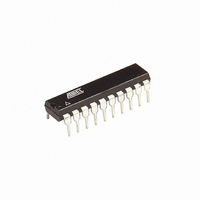ATTINY2313-20PJ Atmel, ATTINY2313-20PJ Datasheet - Page 143

ATTINY2313-20PJ
Manufacturer Part Number
ATTINY2313-20PJ
Description
IC MCU AVR 2K FLASH 20DIP
Manufacturer
Atmel
Series
AVR® ATtinyr
Specifications of ATTINY2313-20PJ
Core Processor
AVR
Core Size
8-Bit
Speed
20MHz
Connectivity
SPI, UART/USART
Peripherals
Brown-out Detect/Reset, POR, PWM, WDT
Number Of I /o
18
Program Memory Size
2KB (1K x 16)
Program Memory Type
FLASH
Eeprom Size
128 x 8
Ram Size
128 x 8
Voltage - Supply (vcc/vdd)
2.7 V ~ 5.5 V
Oscillator Type
Internal
Operating Temperature
-40°C ~ 85°C
Package / Case
20-DIP (0.300", 7.62mm)
Lead Free Status / RoHS Status
Lead free / RoHS Compliant
Data Converters
-
Other names
ATTINY2313-24PJ
ATTINY2313-24PJ
ATTINY2313-24PJ
- Current page: 143 of 226
- Download datasheet (4Mb)
2543L–AVR–08/10
Figure 64. Two-wire Mode, Typical Timing Diagram
Referring to the timing diagram (Figure 64.), a bus transfer involves the following steps:
1. The a start condition is generated by the Master by forcing the SDA low line while the
2. In addition, the start detector will hold the SCL line low after the Master has forced an
3. The Master set the first bit to be transferred and releases the SCL line (C). The Slave
4. After eight bits are transferred containing slave address and data direction (read or
5. If the Slave is addressed it holds the SDA line low during the acknowledgment cycle
6. Multiple bytes can now be transmitted, all in same direction, until a stop condition is given
If the Slave is not able to receive more data it does not acknowledge the data byte it has last
received. When the Master does a read operation it must terminate the operation by force the
acknowledge bit low after the last byte transmitted.
Figure 65. Start Condition Detector, Logic Diagram
SCL line is high (A). SDA can be forced low either by writing a zero to bit 7 of the Shift
Register, or by setting the corresponding bit in the PORT Register to zero. Note that the
Data Direction Register bit must be set to one for the output to be enabled. The slave
device’s start detector logic (Figure 65.) detects the start condition and sets the USISIF
flag. The flag can generate an interrupt if necessary.
negative edge on this line (B). This allows the Slave to wake up from sleep or complete
its other tasks before setting up the Shift Register to receive the address. This is done by
clearing the start condition flag and reset the counter.
samples the data and shift it into the serial register at the positive edge of the SCL clock.
write), the Slave counter overflows and the SCL line is forced low (D). If the slave is not
the one the Master has addressed, it releases the SCL line and waits for a new start
condition.
before holding the SCL line low again (i.e., the Counter Register must be set to 14 before
releasing SCL at (D)). Depending of the R/W bit the Master or Slave enables its output. If
the bit is set, a master read operation is in progress (i.e., the slave drives the SDA line)
The slave can hold the SCL line low after the acknowledge (E).
by the Master (F). Or a new start condition is given.
SDA
SCL
Write( USISIF)
A B
S
C
ADDRESS
SDA
SCL
1 - 7
R/W
8
D
ACK
9
E
DATA
1 - 8
D Q
CLR
ACK
9
D Q
CLR
DATA
1 - 8
USISIF
CLOCK
HOLD
ACK
9
P
F
143
Related parts for ATTINY2313-20PJ
Image
Part Number
Description
Manufacturer
Datasheet
Request
R

Part Number:
Description:
IC, MCU, 8BIT, 2K FLASH, 20SOIC
Manufacturer:
Atmel
Datasheet:

Part Number:
Description:
IC, MCU, 8BIT, 2K FLASH, 20PDIP
Manufacturer:
Atmel
Datasheet:

Part Number:
Description:
IC, MCU, 8BIT, 8K FLASH, 20PDIP
Manufacturer:
Atmel
Datasheet:

Part Number:
Description:
IC, MCU, 8BIT, 8K FLASH, 20SOIC
Manufacturer:
Atmel
Datasheet:

Part Number:
Description:
DEV KIT FOR AVR/AVR32
Manufacturer:
Atmel
Datasheet:

Part Number:
Description:
INTERVAL AND WIPE/WASH WIPER CONTROL IC WITH DELAY
Manufacturer:
ATMEL Corporation
Datasheet:

Part Number:
Description:
Low-Voltage Voice-Switched IC for Hands-Free Operation
Manufacturer:
ATMEL Corporation
Datasheet:

Part Number:
Description:
MONOLITHIC INTEGRATED FEATUREPHONE CIRCUIT
Manufacturer:
ATMEL Corporation
Datasheet:

Part Number:
Description:
AM-FM Receiver IC U4255BM-M
Manufacturer:
ATMEL Corporation
Datasheet:

Part Number:
Description:
Monolithic Integrated Feature Phone Circuit
Manufacturer:
ATMEL Corporation
Datasheet:

Part Number:
Description:
Multistandard Video-IF and Quasi Parallel Sound Processing
Manufacturer:
ATMEL Corporation
Datasheet:

Part Number:
Description:
High-performance EE PLD
Manufacturer:
ATMEL Corporation
Datasheet:










